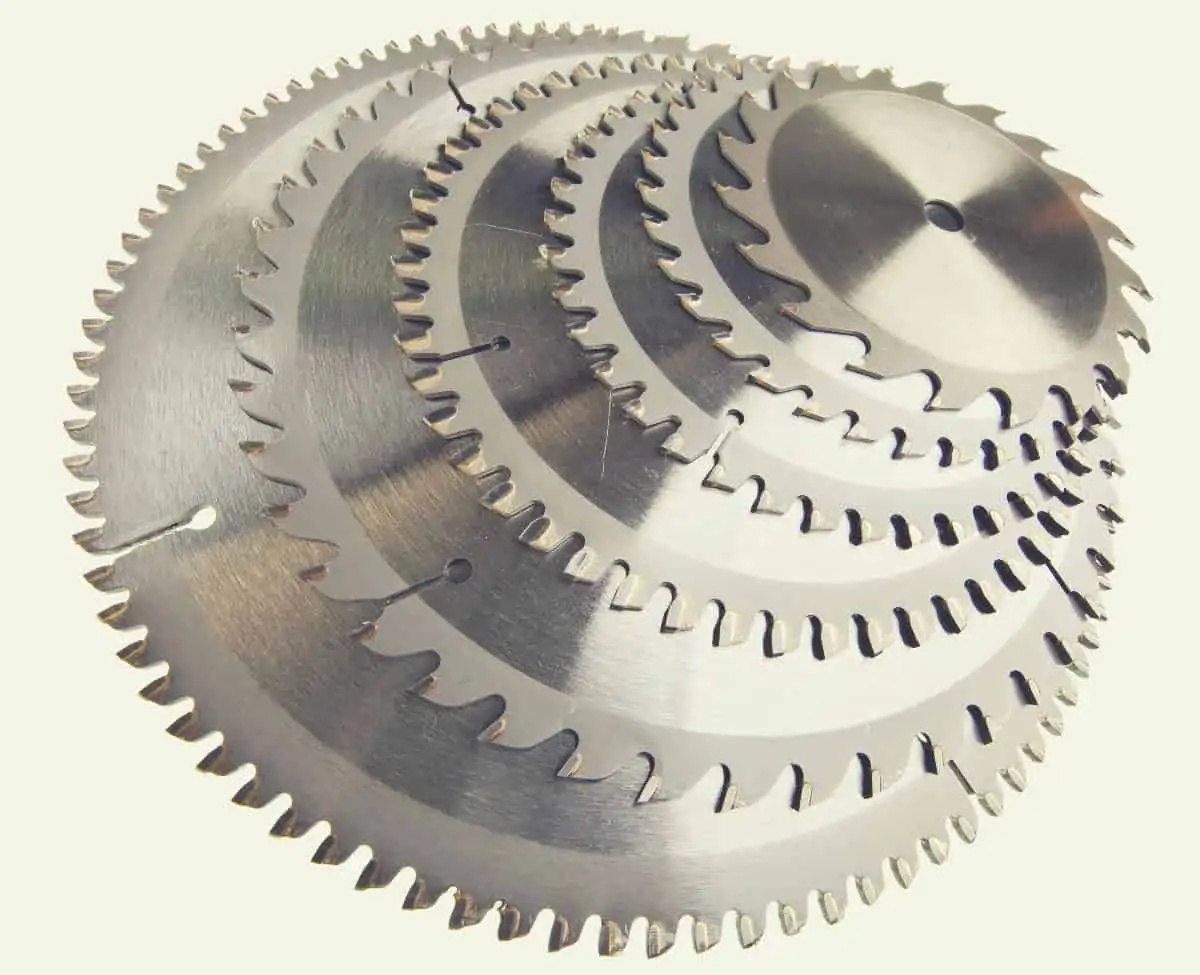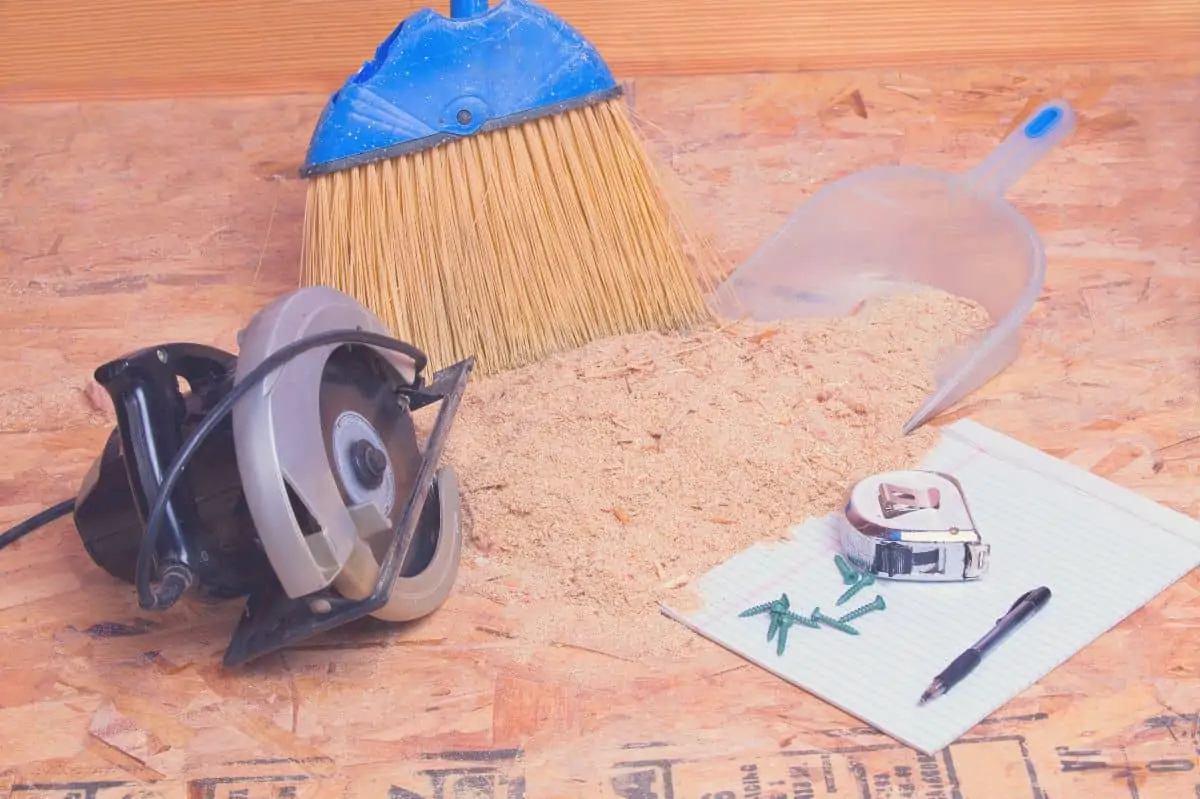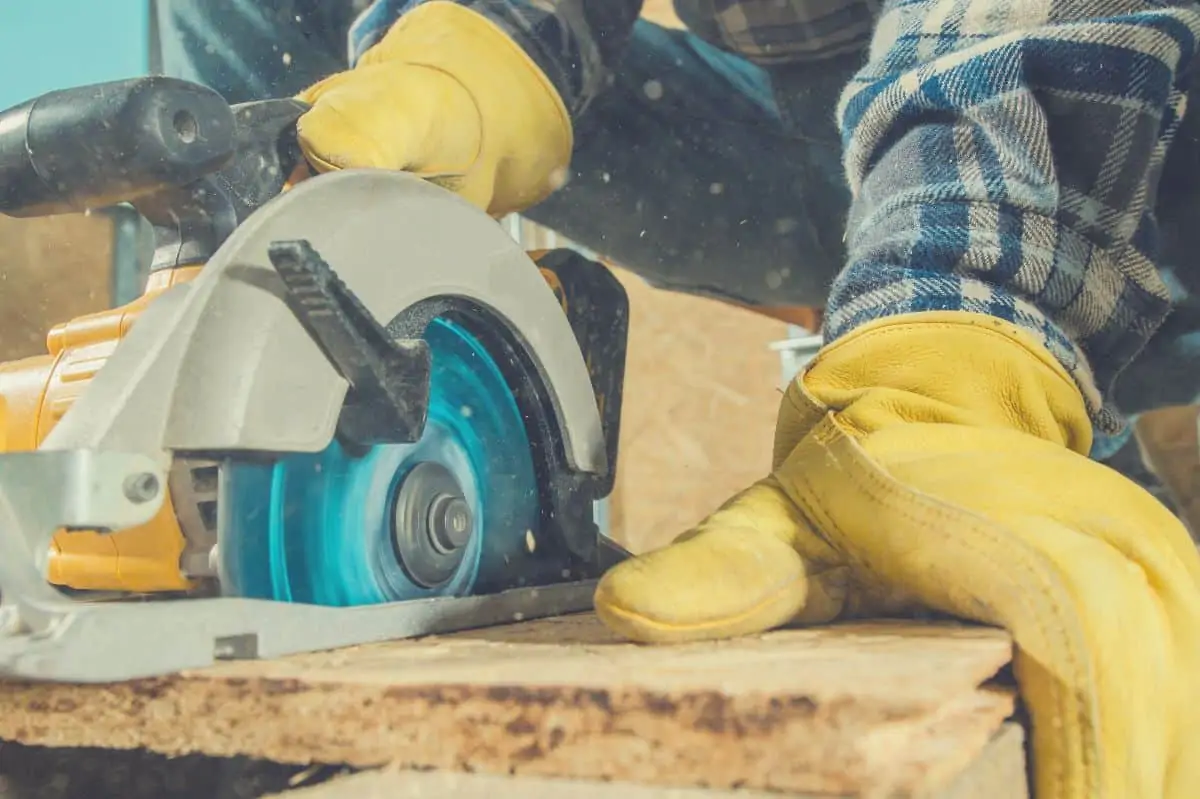Do you ever get confused and overwhelmed by the huge variety of circular saw blades? Choosing the right circular saw blade can have a huge impact on the speed and quality of your cuts. So it’s important for you to consider several factors before making a decision.
Here’s a quick roundup of the best circular saw blades:
- Top Pick – Freud D12100X 100 Tooth Circular Saw Blade
- Top Value Pick – Makita T-01395 16T Carbide-Tipped Saw Blade, General Contractor, 6-1/2
- DEWALT DWA161240 6-1/2-Inch 40-Tooth Circular Saw Blade
- Freud D1060X Diablo 10-Inch Finish Saw Blade
- DEWALT DW3106P5 60-Tooth and 32-Tooth 10- Inch Saw Blade Combo Pack
Our Top Picks for Best Circular Saw Blades 2023
To begin with I’ll show you what I think are the best circular saw blades in 2023 with mini-reviews. This is then followed by a detailed buying guide – exploring features to look for in circular saw blades. Advantages of using one type over another and everything else you need to know when making your decision.
Top Pick – Freud D12100X 100 Tooth Circular Saw Blade
The Freud D12100X will have you covered for all of your finishing work. I’ve always struggled to find one that offers precise and clean cuts without any tearing.
With this product there’s no compromise on the quality of the finish no matter what material you’re cutting.
This circular saw blade is perfect for producing smooth finish cuts on a range of materials. Which Freud claims is at least as smooth as a finish applied by 220-grit sandpaper.
The ultra thin kerf and high density carbide tips mean it glides effortlessly through almost any material. Including molding, hard or softwoods, veneered plywood or melamine.
Pros
- Side grind tooth geometry leaves 220-grit finish.
- 100 teeth produce precise and clean cuts.
- High density carbide tips
Cons
- Relatively expensive
The Freud D12100X 100 tooth circular saw blade is the champion when it comes to finishing work. Cutting the mustard even for professionals. Due to its unique tooth profile and carbide coating, you won’t have any challenges when you want a smooth, clean cut.
Top Value Pick – Makita T-01395 16T Carbide-Tipped Saw Blade, General Contractor, 6-1/2’’
Like most people when looking for a general purpose workhorse I always look for a product that’s not only high-quality but doesn’t cost too much. That’s exactly what I found with the Makita T-01395 16T carbide-tipped circular saw blade.
It has been specially designed for cordless saws, the ultra-thin kerf means you can make more cuts per charge. Combined with carbide-tipped teeth, cuts will be smooth with very little drag to strain the motor.
One slight disadvantage of the product is that it might not be rigid enough to cut through tough hardwood such as walnut. However if you find this to be an issue you can always tackle the issue by making multiple cuts until you cut all the way through.
Pros
- Quick ripping
- Low drag on motor
Cons
- Dulls quickly cutting hard wood
The Makita T-01395 16T carbide-tipped circular saw blade makes more cuts per charge and its design offers minimal material loss and drag to the motor.
Other Circular Saw Blades Worthy of Consideration
While the two blades above clinched the top spots for top pick and top value pick, which blade is best for you will depend on the type of work you’ll be doing. The remaining blade on this list are definitely worth a look if the blades discussed so far didn’t fit the bill.
DEWALT DWA161240 6-1/2-Inch 40-Tooth Circular Saw Blade
There’s nothing worse than feeling your circular saw kickback as you hit a nail, wondering how many teeth are missing this time. Does this sound familiar? With the reinforced shoulder on the Dewalt DWA161240 impact resistance is increased. The improvement to strength and durability should mean missing teeth are the thing of the past.
The ultra-thin kerf and low friction coating reduces gumming. Making it perfectly suited to cordless circular saws. More time cutting less time charging.
Traditionally with thin kerf blades you trade off reduced motor drag for rigidity. Resulting in vibrations through the saw. This is a particular pain while trying to rip hardwoods. Dewalts patented body slots attempt to mitigate the vibrations. Making and optimal choice for both corded and cordless circular saws.
The only drawback I could find is that it does drain the battery on a cordless saw a little faster than other saw blades on the market. Although the finish it leaves on every cut is hard to match, so for me I can deal with more time charging.
Pros
- Impact resistant teeth
- Anti-stick coating reduces gumming
- Low vibration when ripping
Cons
- Relatively high motor drag
The DEWALT DW9196 40T precision circular saw blade is packed with impressive features. And all for a reasonable price that will satisfy both a professional and a DIYer.
Freud D1060X Diablo 10-Inch Finish Saw Blade
If you’re like me, the one thing I dread doing with finishing work is excessive sanding. With it’s special tooth geometry, high density carbide coating and 60 tooth count the Freud D1060X keeps sanding to a minimum.
With an ultra-thin kerf of 0.098-inch it’s ideal for more delicate cuts in all types of wood. The lazer cut alternate-top bevel teeth make controlling the feed and position easier than other blades. This gives the confidence required to make those high precision cuts where accuracy is key.
It’s hard to find anything negative apart from the high end price tag.
Pros
- Low friction
- ParmaShield non-stick coating
- Smooth and accurate cuts.
Cons
- Relatively expensive
When it comes to finishing the Freud D1060X Diablo 10-inch is the perfect choice for making your work more efficient.
DEWALT DW3106P5 60-Tooth Crosscutting and 32-Tooth General Purpose 10-Inch Saw Blade Combo Pack
For the dedicated home carpenter, the DW3106P5 is an excellent blade for cross-cutting. What’s more in this combo pack you also get a carbide-tipped 32 tooth blade which is ideal for ripping boards. Between the two you’ll be able to get the best out of your DIY projects around the house or yard. DeWalt delivers as usual here. It’s not a surprise that they’re making our list of top circular saw blades. Home carpenters often end up needing blades for both ripping and cross-cutting, with this 2-pack you don’t need to waste any more time looking. It’s not as convenient as a dual-purpose circular saw blade but switching out tends to get both jobs done better. Now, the low price of the 2-pack is great but these may not be what you’re looking for as a professional. The cuts are smooth but the durability to cut materials like oak hardwood day in day out. For the home DIYer, however, it’s unnecessary to have that much durability. This pack, and particularly the cross-cutting blade, deserve a place on our list. The DEWALT combo pack is a great choice for DIYers looking for affordable blades and versatility. With the variety of types on the market, there are a few things to consider deciding which circular saw blade is the right one for you. General-Purpose – General-Purpose Blades, also known as combination blades, have the perfect balance of tooth count and size. This is the perfect choice for DIYers or an all around handyman who need to tackle a range of jobs which require different cuts. Ripping – With a large tooth profile and a low tooth count ripping bales are designed to cut along the length of boards with the grain of the wood. With large gullets and rake angle ripping blades remove material quickly giving a high feed rate. Crosscutting – Cross cutting saw blades have smaller teeth and gullets than general-purpose and ripping blades. They don’t remove material as quickly and feed rates are generally slower. Crosscutting blades are designed to cut across the grain so typically have a higher tooth count. Finishing – Finishing saw blades are used when high precision is required. They have a higher tooth count again to create a smooth finish to each cut with minimal splintering. A really good finishing blade could if need no sanding at all depending on how clean you need your finish. Metal-Cutting – When it comes to cutting metals, there is the category of metal cutting blades that are toothless and cut at high speeds using abrasive edges. Some typical abrasive materials are aluminum oxide, silicon carbide, zirconia alumina and even diamond! Masonry – Masonry blades are designed to cut hard materials like concrete and natural stone, and come in two varieties. One is for softer materials such as limestone, bricks and concrete block. The other is for marble, granite and glazed ceramic. There are five different tooth shapes, and each exists to define what kind of cut you’ll get. Flat-top grind (FTG) tooth profile is suited best for ripping along the length of the grain. As the name suggests the tooth is flat across the thickness of the blade. This makes for a durable tooth ideal for quick rips, however can lead to tearing and splintering. Triple-chip grind (TCG) tooth profile is similar to the flat-top grind however every other tooth has a trapezoidal tip that cuts and angled grove. It’s then followed by a flat-topped tooth which completes the cut. This alternating pattern reduces cutting force and drag and reduces the chance of splintering and tearing. It’s is normally used to cut brittle materials like MDF, chipboard or laminates which are prone to splitering or chipping. Alternate top bevel (ATB) tooth profile alternates between teeth beveled to the left and the right. Typically at an angle of 15 degrees. The tip of each tooth gives a sharper cutting edge and focuses the cutting force reducing friction and the risk of chipping or tearing. The result is a cleaner finish compared to flat-top of triple-chip grind profiles. However the downside is feed rates tend to be slower and they dull quicker. High alternate top bevel (high ATB) tooth profile is pretty much the same as a ATB profile with the only difference being a steeper bevel angle. High ATB blades are normally defined by a bevel and of over 20 degrees. The steeper angle leads to an even sharper cutting edge. This makes these blades perfect for finishing or cutting brittle materials like laminates. Alternate top bevel with raker (ATBR) tooth profile combines the high quality finish associated with a ATB profile with the high feed rate of a FTG profile. The types of tooth profile are typically found in a ratio of 1:4 with 1 FTG tooth for every 4 ATB teeth. Naturally there is some compromise, you won’t get the speed of a ripping blade and the finish of a finishing blade. But the combination works well to make a general purpose blade. Another feature of a circular saw blade that people often mistake for being part of the tooth profile are the expansion slots . They’re normally found at the bottom of the gullet of a few teeth found the circumference of the blade and extend untoward the center. In fact the expansion slot have nothing to do with cutting. They are actually to leave the stresses in the metal cause by the thermal expansion as it gets hot from cutting. Without expansion slots the blade would be likely to warp and bend when it gets too hot. The exact number of teeth will depend on a number of things such as the type of cutting it’s designed to do, the size and the tooth profile. However these are some of the general things to look for when assessing tooth count. The number of teeth is there to indicate how fast the blade works and how rough the results would be. The lower the tooth count, the quicker it’ll cut through the material, but it’ll leave a rougher a cut. Lower tooth counts are normally found on ripping and general purpose blades. For crosscuts and where smooth finishes are required a high tooth count is generally a better choice. However the feed rate will be slower and the blades will dull quickly if it gets heavy or you end up using it for ripping. To choose the blade size, you need to first know the size of your saw. The most common size of a blade for a circular saw is 7.25 inches but some saws can range from 6.5 inches to 7.5. Table and miter saws are usually between 10 and 12 inches. To make the right decision check the size of your saw and match it with the size of the blade. The Kerf of a circular saw blade is the thickness of the cut made by the blade. With Kerf thickness you’re basically trading off blade rigidity and drag. With a thicker kerf being more rigid but with a higher drag. Thicker kerf blades are best for fast ripping as long as you have a saw that’s powerful enough to keep up as the increased drag can bog down less powerful saws. If you try ripping too quickly with a thin kerf blade you often find the rigidity just isn’t there and you’ll get vibrations through the saw. You’re also likely to find the blade will dull quickly if it’s not right for the job. For finishing jobs ultra-thin kerf blades are generally more suitable. The waste material is kept to a minimum and making cut precision tends to be easier to maintain. However the biggest advantage is in prolonging the battery life of cordless saws. This is because the reduced drag means less energy is required to cut through the material. There are two areas of the blade where coatings are important: the main body of the blade, referred to as the plate, and the teeth. The coating serves different purposes however each is important to the functionality of the blade. Most blades will have some kind of coating on the plate, even if it’s just for blade identification and branding. It also protects the blade from rust and corrosion. Some blade coatings however have a functional purpose, namely to reduce friction. Most friction reducing coatings are PTFE based, PTFE is a synthetic polymer which most people will know by its brand name Teflon. PTFE has one of the lowest coefficients of friction of any solid. Which makes it perfect for reducing the friction between the blade and the material as you make a cut. It also means that dust and debris from the removed material won’t stick to the blade. This is the cause the majority of the friction while cutting comes from. This reduction in friction means less drag on the motor which is most useful on cordless saws. Less friction-less drag-less energy-more battery life. The teeth on the blade do the grunt work, right at the edge of the blade they’re tooth tip is traveling faster than any other point on the blade. Each tooth striking and ripping through the material thousands of times a minute. The friction involved with such a task means that the tooth tips can reach temperatures close to the melting point of high speed steel the blade is constructed from. While some cheaper blades are left untreated, this extreme heat can lead to blade dulling very quickly. The solution? To coat the teeth with a material with an extremely hard material with a really high melting point. The material of choice is tungsten carbide. Tungsten carbide tipped blades, normally labeled as TCT, have tungsten carbide tips braised onto the high speed steel plate of the blade. The properties of the teeth are often even further improved by electroplating them with materials like titanium, cobalt or vanadium. These coatings can make the surface even harder further reducing wear and increasing the length of time until the blade dulls. The only downside to carbide tipped blades is that they cannot be easily sharpened and require special equipment to do so. Where TCT blades have been coated, resharpening the blade will remove the surface coating. Hopefully this article has given you enough information on the best circular saw blades to help you make an informed decision. As you can see, there are lots of factors to consider and it’s not always an easy choice. I recommend choosing a saw that’s tough enough to cut the toughest material you might encounter. However you also need to consider the type of cutting you’ll be doing to chose the right saw blade for you. My top pick from this list is the Freud D12100X. For me it really is hard to beat when it comes to producing a flawless finish.. If you think there are any other solid contenders for the best circular saw blade then let me know below!Pros
Cons
What to Look for When Choosing the Best Circular Saw Blade?
Blade Types
Tooth Shape
Tooth Count
Size
Kerf
Blade Material & Coating
Plate Coating
Tooth Coating
Conclusion








